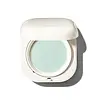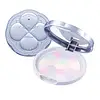What's inside
What's inside
 Key Ingredients
Key Ingredients

 Benefits
Benefits

 Concerns
Concerns

 Ingredients Side-by-side
Ingredients Side-by-side

Silica
AbrasiveCaprylic/Capric Triglyceride
MaskingDimethicone/Vinyl Dimethicone Crosspolymer
Skin ConditioningMethicone
EmollientWater
Skin ConditioningChamomilla Recutita Flower Water
MaskingEthylhexylglycerin
Skin ConditioningGlyceryl Caprylate
EmollientButylene Glycol
HumectantMentha Arvensis Leaf Extract
MaskingDipotassium Glycyrrhizate
Humectant1,2-Hexanediol
Skin ConditioningHydrolyzed Hyaluronic Acid
HumectantHydrolyzed Corn Starch
HumectantPinus Densiflora Leaf Extract
AntimicrobialTocopherol
AntioxidantDisodium EDTA
Silica, Caprylic/Capric Triglyceride, Dimethicone/Vinyl Dimethicone Crosspolymer, Methicone, Water, Chamomilla Recutita Flower Water, Ethylhexylglycerin, Glyceryl Caprylate, Butylene Glycol, Mentha Arvensis Leaf Extract, Dipotassium Glycyrrhizate, 1,2-Hexanediol, Hydrolyzed Hyaluronic Acid, Hydrolyzed Corn Starch, Pinus Densiflora Leaf Extract, Tocopherol, Disodium EDTA
Talc
AbrasiveMethoxycyclododecane
PerfumingVinyl Dimethicone/Methicone Silsesquioxane Crosspolymer
Diisostearyl Malate
EmollientSilica
AbrasiveZinc Laurate
Squalane
EmollientTriethylhexanoin
MaskingButylene Glycol
HumectantBHT
AntioxidantArgania Spinosa Kernel Oil
EmollientArnica Montana Flower Extract
MaskingChamomilla Recutita Flower Extract
MaskingDimethicone
EmollientEquisetum Arvense Extract
AstringentHedera Helix Leaf/Stem Extract
AntimicrobialQuercus Robur Bark Extract
AstringentRosa Centifolia Flower Extract
AstringentCamellia Sinensis Leaf Extract
AntimicrobialTocopherol
AntioxidantPerfluorooctylethyl Triethoxysilane
Hamamelis Virginiana Leaf Extract
Skin ConditioningSodium Hyaluronate
HumectantButylparaben
MaskingVitis Vinifera Leaf Extract
Skin ConditioningDipentaerythrityl Hexahydroxystearate
EmulsifyingSimmondsia Chinensis Seed Oil
EmollientMica
Cosmetic ColorantMethylparaben
PreservativeSaxifraga Sarmentosa Extract
Skin ConditioningWater
Skin ConditioningSoluble Collagen
HumectantSynthetic Fluorphlogopite
Tin Oxide
AbrasiveTitanium Dioxide
Cosmetic ColorantIron Oxides
CI 45380
Cosmetic ColorantCI 77120
Cosmetic ColorantTalc, Methoxycyclododecane, Vinyl Dimethicone/Methicone Silsesquioxane Crosspolymer, Diisostearyl Malate, Silica, Zinc Laurate, Squalane, Triethylhexanoin, Butylene Glycol, BHT, Argania Spinosa Kernel Oil, Arnica Montana Flower Extract, Chamomilla Recutita Flower Extract, Dimethicone, Equisetum Arvense Extract, Hedera Helix Leaf/Stem Extract, Quercus Robur Bark Extract, Rosa Centifolia Flower Extract, Camellia Sinensis Leaf Extract, Tocopherol, Perfluorooctylethyl Triethoxysilane, Hamamelis Virginiana Leaf Extract, Sodium Hyaluronate, Butylparaben, Vitis Vinifera Leaf Extract, Dipentaerythrityl Hexahydroxystearate, Simmondsia Chinensis Seed Oil, Mica, Methylparaben, Saxifraga Sarmentosa Extract, Water, Soluble Collagen, Synthetic Fluorphlogopite, Tin Oxide, Titanium Dioxide, Iron Oxides, CI 45380, CI 77120
 Reviews
Reviews

Ingredients Explained
These ingredients are found in both products.
Ingredients higher up in an ingredient list are typically present in a larger amount.
Butylene Glycol (or BG) is used within cosmetic products for a few different reasons:
Overall, Butylene Glycol is a safe and well-rounded ingredient that works well with other ingredients.
Though this ingredient works well with most skin types, some people with sensitive skin may experience a reaction such as allergic rashes, closed comedones, or itchiness.
Learn more about Butylene GlycolSilica, also known as silicon dioxide, is a naturally occurring mineral. It is used as a fine, spherical, and porous powder in cosmetics.
Though it has exfoliant properties, the function of silica varies depending on the product.
The unique structure of silica enhances the spreadability and adds smoothness, making it a great texture enhancer.
It is also used as an active carrier, emulsifier, and mattifier due to its ability to absorb excess oil.
In some products, tiny microneedles called spicules are made from silica or hydrolyzed sponge. When you rub them in, they lightly polish away dead skin layers and enhance the penetration of active ingredients.
Learn more about SilicaTocopherol (also known as Vitamin E) is a common antioxidant used to help protect the skin from free-radicals and strengthen the skin barrier. It's also fat soluble - this means our skin is great at absorbing it.
Vitamin E also helps keep your natural skin lipids healthy. Your lipid skin barrier naturally consists of lipids, ceramides, and fatty acids. Vitamin E offers extra protection for your skin’s lipid barrier, keeping your skin healthy and nourished.
Another benefit is a bit of UV protection. Vitamin E helps reduce the damage caused by UVB rays. (It should not replace your sunscreen). Combining it with Vitamin C can decrease sunburned cells and hyperpigmentation after UV exposure.
You might have noticed Vitamin E + C often paired together. This is because it is great at stabilizing Vitamin C. Using the two together helps increase the effectiveness of both ingredients.
There are often claims that Vitamin E can reduce/prevent scarring, but these claims haven't been confirmed by scientific research.
Learn more about TocopherolWater. It's the most common cosmetic ingredient of all. You'll usually see it at the top of ingredient lists, meaning that it makes up the largest part of the product.
So why is it so popular? Water most often acts as a solvent - this means that it helps dissolve other ingredients into the formulation.
You'll also recognize water as that liquid we all need to stay alive. If you see this, drink a glass of water. Stay hydrated!
Learn more about Water